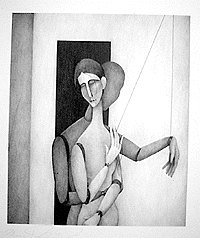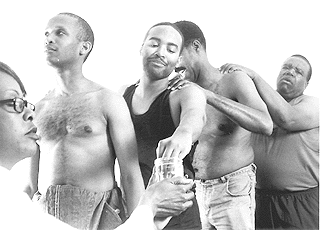Exhibitionism
Chronicle Arts Reviews
Fri., Feb. 20, 1998
MISS EVERS' BOYS: CONDEMNED FOR THE SAKE OF SCIENCE
The Public Domain,
through March 14
Running Time: 2 hrs, 15 min
The road to hell is paved with good intentions. In the heart of every cliché lives a kernel of truth. Good intentions also pave the way to Macon County, Alabama, a new kind of hell for four men and one nurse who are forced into a truly dehumanizing situation simply because they tried to do the right thing. But the right thing is, in the best of circumstances, difficult to determine, and determining it in this situation is made harder by a lack of real information and a plenitude of overwhelming prejudice in the backwaters of the South.
Miss Evers' Boys, produced by First Stage Productions, proves just how quickly the road to hell can be paved. Based on the reality of the Tuskegee Study, a government-funded experiment in a small Southern town in which African-American men with syphilis were examined but not treated. This lack of care would eventually lead the men to a shuffling, crazed death as the virus set up house in their spinal columns and seriously inhibited the nervous impulses traveling through it. Not the greatest way to go and almost unavoidable until the advent of penicillin, a drug that these men were denied even after its widespread use. But, of course, the motivations for watching these men die becomes mixed into a knot of the aforementioned good intentions and downright stupidity. Miss Evers' Boys is based on the Tuskegee Study, but facts and attributions have been subtly shifted to create a smoother dramatic arc as well as to divine what some of these folks were thinking when they condemned a generation of men to death for the sake of science.
Eunice Evers, the nurse who comes to Macon County to convince the men that the government has their best interests at heart, is earnest and kind, the kind of person who only wants to help. Melissa Waddy-Thibodeaux gives a strong, touching performance as Miss Evers; you can almost feel waves of compassion rolling into the audience. As the script wears on, the waves become harsh currents of frustration, forced by the antics of the researchers who are equally trapped by their own compulsions to continue the study despite the human costs. Robert Pellette, Jr. broods as Dr. EugeneBrodus while John Kanady produces a strange, stiff, unbelievable performance as Dr. John Douglas. It's hard to tell if Kanady's characterization is unintentional or a specific acting choice to bolster the script's impression of Douglas as a man whose words cannot be trusted.
Then there are the boys themselves, a mixed bag of farmers and laborers who are justifiably lured into the experiment by the promise of free health care. While each man has a distinct personality and level of literacy, each puts his trust in Miss Evers, a confidence she does her best not to betray. As these human guinea pigs, Vincent H. Johnson, Ronald Bell, Jerod Williams, and Tim Curry give heartfelt yet tentative performances that will, hopefully, fill the entire theatre and into the lobby as the performers gain confidence in David Feldshuh's intelligent, gripping script.
It is these performances that remain with you after the final bows are taken, despite Roy Watson's evocative set and Diane Talley's simple, effective costumes. You start to care about these men who are stuck in this deadly situation, trapped by someone who only has their interests in mind. Fortunately, the best intentions of this show's production team have steered this show, which could have been a preachy downer, to a much nicer, less torturous place than the one at the end of Miss Evers' ministrations.– Adrienne Martini
WORKS BY ROLAND PANTERMUEHL: SO MANY PINOCCHIOS
Metropolitan Gallery,
ongoing
 There is a new gallery in our midst. While certainly a welcome addition – it's a small sign of growth that is essentially a positive move for the local arts scene – the Metropolitan can be a bit tedious for the viewer. Perhaps its name represents the innately confined conditions of a densely packed urban area, because it's a mighty tight fit in the small space. Viewers must weave their way around desks and framing supplies to get a good look at much of the work, since the gallery is essentially a framing shop utilizing wall space for original art.
There is a new gallery in our midst. While certainly a welcome addition – it's a small sign of growth that is essentially a positive move for the local arts scene – the Metropolitan can be a bit tedious for the viewer. Perhaps its name represents the innately confined conditions of a densely packed urban area, because it's a mighty tight fit in the small space. Viewers must weave their way around desks and framing supplies to get a good look at much of the work, since the gallery is essentially a framing shop utilizing wall space for original art.
The tight quarters might be a little frustrating for the average gallery-goer, but despite the cramped conditions, there are some nice pieces to discover among the sculptures, paintings, and photos by 10 or so artists that take up just about every spare inch of the framing-area-cum-exhibition-space. One corner of the room features a particularly interesting cluster of works by Roland Pantermuehl.
Pantermuehl's series of small prints and drawings offer an oblique narrative as told by his ghostlike figures, characters reminiscent of those by underappreciated Spanish surrealist Remedios Varo. Works by both artists depict bodies with long, spindly extremities and expressions that are at once enthralling and chilling. Whereas Varo gives colorful, intricate detail to his backgrounds and surroundings, Pantermuehl's black-and-white designs are simpler, relying on the characters' expressions to convey the narratives, narratives that appear – by the looks on the characters' long faces – sweetly melancholy.
Pantermuehl's figures are moody, marionette-like creatures, virtually without detail on their smooth, wooden-looking bodies. Yet they are animated and thoughtful, with their petite lips, mournfully wide, often downcast eyes, and a few tousled locks of hair lending them a human feel, like so many Pinocchios coming to life. The world Pantermuehl has given them is sparse, dark, and shadowy, resembling the emotions emitted by their sad visages.
Other works worth exploring are Karen Lastre's large-scale abstracts. Access to the Spirit is a mesh of brilliant blues and reds, as though a wave of crimson molten lava is creeping into a densely azure sky, creating a colorful collision that is intensely hypnotic. Lastre's works are appealing and evocative, even though they're obstructed by other artists' sculptures. – Cari Marshall









